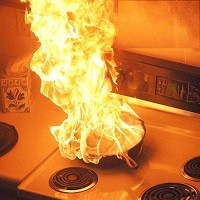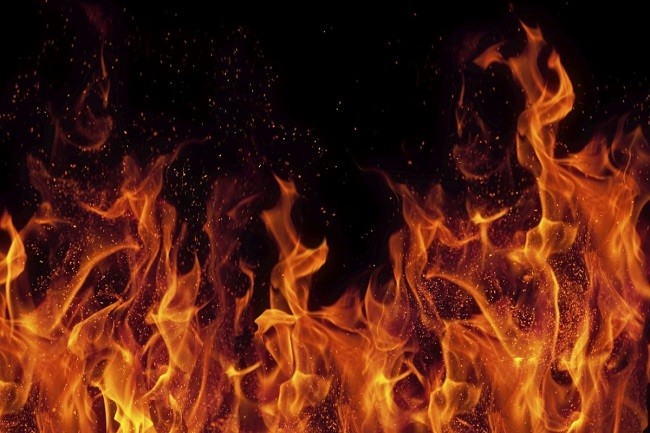
دانلود رایگان تحقیق انگلیسی 5 نوع آتش با ترجمه فارسی
سازمان های آتش نشانی تنها در ایالات متحده سالانه به بیش از یک میلیون آتش سوزی رسیدگی می کنند و در حالی که این تعداد از دهه 1970 به طور پیوسته در حال کاهش بوده است، آتشسوزیها همچنان پتانسیل ایجاد موقعیتهای بسیار خطرناک را در هر زمان دارند. اما در حالی که همه آنها می سوزند، یکسان نیستند. به منظور گروه بندی آتش ها - و راه های خاموش کردن آنها - کارشناسان آتش نشانی سیستمی را برای طبقه بندی آتش ها ایجاد کردند.
بنابراین طبقه بندی آتش چه چیزی را توضیح می دهد؟ طبقه بندی آتش، منبع سوخت موجود را علاوه بر سایر ویژگی های مشترک از جمله بهترین روش خاموش کردن یا مهار آن، توصیف می کنند. اگر در صنعتی با خطر آتش سوزی کار می کنید، مانند ماشینکاری دقیق، درک انواع آتش هایی که ممکن است با آن مواجه شوید بسیار مهم است. این تحقیق را بخوانید تا در مورد انواع مختلف آتش و اینکه چه موادی برای خاموش کردن آنها مناسب هستند، آشنا شوید.

چگونه آتش طبقه بندی می شود؟
آتش بر اساس مواد یا ماده های موجود در دسته هایی طبقه بندی میشوند. اما چند نوع آتش وجود دارد؟ در ایالات متحده، پنج دسته اصلی آتش وجود دارد که در زیر توضیح داده شده اند. با این حال، توجه به این نکته مهم است که در سایر کشورها - از جمله کشورهای اروپایی و همچنین استرالیا - نام ها و ویژگی های این طبقه بندی متفاوت است. به عنوان مثال، در ایالات متحده، طبقه بندی آتش توسط انجمن ملی حفاظت از آتش (NFPA) نامگذاری می شوند، در حالی که در اروپا توسط طبقه بندی استاندارد آتش اروپا کنترل می شوند.
درک نوع آتش موجود می تواند به همه افراد درگیر کمک کند تا بدانند چقدر وجود دارد و چگونه آن را مهار یا خاموش کنند.
طبقه بندی آتش به 5 دسته چگونه است؟
پنج نوع آتش عبارتند از: A، B، C، D و K. بیایید انواع مختلف آتش، از جمله منابع سوخت، خطرات و روش های رایج مورد استفاده برای مهار آنها را بررسی کنیم.
آتش نوع A
آتش نوع A رایج ترین نوع آتش است. آنها از مواد قابل احتراق معمولی از جمله چوب، کاغذ، پارچه، لاستیک و پلاستیک تولید می شوند. آتش سوزی های نوع A دمای احتراق نسبتاً پایینی دارند و هنگامی که سوخت یا اکسیژن تمام شد، آتش خاموش می شود. آتش زباله یکی از نمونه های آتش نوع A است. به طور کلی، اگر آتش خاکستری را برجا بگذارد، احتمالاً آتش نوع A است.
آب و کف اغلب برای مهار آتش نوع A استفاده می شوند.
آتش نوع B
آتش نوع B زمانی رخ می دهد که مایعات یا گازهای قابل اشتعال مانند الکل، نفت سفید، رنگ، بنزین، متان، خنک کننده های مبتنی بر روغن یا پروپان مشتعل شوند. آتش نوع B بیشتر در محیطهای صنعتی رایج است، اما ممکن است در محیطهای مسکونی یا تجاری نیز رخ دهد. آتش نوع B نقطه اشتعال پایینی دارند، به این معنی که اگر در معرض منبع آتش قرار بگیرند، به راحتی در هر دمایی میسوزند. آتش نوع B نیز به سرعت گسترش مییابند و هنگام سوختن دود سیاه غلیظی تولید میکنند.
آب هنگام برخورد با آتش نوع B موثر نیست. در عوض، دی اکسید کربن (CO2) یا عوامل شیمیایی خشک اغلب برای مهار این آتش استفاده می شود.
آتش نوع C
آتش نوع C به آتشهایی گفته میشود که دارای جریان الکتریکی یا تجهیزات الکتریکی به عنوان منبع سوخت هستند. چنین منابع سوختی می توانند شامل ابزار الکتریکی، لوازم برقی، موتورها و ترانسفورماتورها باشد. آتش نوع C در محیط های صنعتی که با انرژی یا تجهیزات برقی مانند توربینهای بادی سروکار دارند، رایجتر است. با این حال، آتش نوع C میتواند در محیط های تجاری یا مسکونی نیز به دلیل مشکلاتی مانند سیمکشی معیوب رخ دهد.
آتش الکتریکی را نمیتوان با آب مهار کرد - در واقع، میتواند آن را بدتر کند. در عوض، باید یک عامل شیمیایی غیر رسانا، از جمله عوامل تمیز کننده، برای خاموش کردن شعله استفاده شود.
آتش نوع D
آتش نوع D آتشی را توصیف میکنند که با منبع سوخت فلزی قابل احتراق رخ میدهند. فلزات قابل احتراق متداول عبارتند از: آلومینیوم، لیتیوم، منیزیم، پتاسیم، تیتانیوم و زیرکونیوم. این نوع فلزات قابل احتراق بیشتر در آزمایشگاه ها و در تولید استفاده می شوند، بنابراین بزرگترین خطر برای آتش نوع D در صنایع رخ می دهد.
آب می تواند باعث انفجار برخی از فلزات قابل احتراق شود، بنابراین نباید از آن برای مهار آتش نوع D استفاده کرد. در عوض، پودر خشک را می توان برای جذب گرما و خفه کردن شعله ها با مسدود کردن اکسیژن آتش استفاده کرد.
آتش نوع K
در نهایت، آتش نوع K، آتشهای پخت و پز هستند که در نتیجه احتراق مایع پخت و پز مانند گریس، روغن، چربی گیاهی یا چربی حیوانی رخ میدهند. آتش نوع K از نظر فنی نوعی آتش مایع هستند، اما به دلیل خاصیت منحصر به فردشان به عنوان نوع جدا در نظر گرفته میشوند. آتش نوع K بیشتر در صنعت خدمات غذایی و رستورانها رایج است، اما میتواند در هر آشپزخانه ای رخ دهد.
آب مانند سایر حریق های مایع، نباید روی آتش نوع K پاشیده شود. به جای آن، عوامل شیمیایی مرطوب بهترین روش برای استفاده هستند.
خطرناک ترین نوع آتش کدام است؟
هر نوع آتشی سطحی از خطر را به همراه دارد. اگرچه به طور کلی، آتشسوزی هایی که به احتمال زیاد منفجر میشوند یا به سرعت گسترش مییابند، اغلب خطرناک ترین نوع هستند و میتوانند علاوه بر خسارت مالی باعث صدمات جدی شوند. به همین دلیل است که درک انواع آتش و بهترین روش خاموش کردن یا مهار آن بسیار مهم است.
منبع:
firetrace.com/fire-protection-blog/5-classes-of-fire
Fire departments respond to more than one million fires each year in the United States alone. And while that number has been steadily decreasing since the 1970s, fires still present the potential for extremely hazardous situations whenever they occur. But while they all burn, not all fires are the same. In order to group fires—and the ways to extinguish them—fire professionals developed a system to classify fires.
So what does a fire class describe? Fire classes describe the fuel source present in addition to other common features, including how best to extinguish or suppress it. If you work in an industry with an increased risk of fire, like precision machining, it is important to understand the types of fires you might face. Read this article to learn about the different fire types and what materials are best suited to fight them.
How are Fires Organized into Classes?
Fires are grouped into classes based on the materials or substances that are present. But how many classes of fires are there? In the United States, there are five basic classes of fire, which are described below. However, it is important to note that other countries—including those in Europe as well as Australia—the names and properties of these classes differ. For example, in the United States, fire classes are named by the National Fire Protection Association (NFPA), while in Europe they are controlled by the European Standard Classification of Fires.
Understanding the type of fire present can help everyone involved know how dangerous it is and how to suppress or extinguish it.
What are the 5 Classes of Fire?
The five types of fires include: A, B, C, D, and K. Let’s explore the different types of fire, including fuel sources, dangers, and common methods used to fight them.
Class A Fire
Class A fires are the most common type of fire. They are produced from common combustible materials including wood, paper, fabric, rubber, and plastic. Class A fires have relatively low ignition temperatures, and once the fuel or oxygen has been depleted, the fire will burn out. A garbage fire is one example of Class A fires. Generally speaking, if the fire leaves ash behind, it’s likely a Class A Fire.
Water and foam agents are most often used when fighting Class A fires.
Class B Fire
Class B fires occur when flammable liquids or gases such as alcohol, kerosene, paint, gasoline, methane, oil-based coolants, or propane ignite. Class B fires are most common in industrial settings, but they may also occur in residential or commercial settings. Class B fires have a low flashpoint, which means they burn easily at any temperature if exposed to a fire source. Class B fires also spread rapidly and produce a thick black smoke as they burn.
Water is not effective when dealing with Class B fires. Instead, Carbon Dioxide (CO2) or dry chemical agents are often used to fight these fires.
Class C Fire
Class C fires are those fires that have live electrical currents or electrical equipment as a source of fuel. Such fuel sources could include electric tools, appliances, motors, and transformers. Class C fires are most common in industrial settings that deal with energy or electrically-powered equipment, like wind turbines. However, Class C fires can also occur in commercial or residential settings due to issues like faulty wiring.
Electrical fires cannot be fought with water—in fact, it can make it worse. Instead, a non-conductive chemical agent, including clean agents, should be used to put out the flames.
Class D Fire
Class D fires describe those fires that occur with a combustible metal fuel source. Common combustible metals include aluminum, lithium, magnesium, potassium, titanium, and zirconium. These types of combustible metals are most often used in laboratories and in manufacturing, so the biggest danger for Class D fires occurs in these industries.
Water can cause some combustible metals to explode, so it should not be used to fight Class D fires. Instead, dry powder agents can be used to absorb heat and smother the flames by blocking off the fire’s oxygen supply.
Class K Fire
Finally, Class K fires are cooking fires that occur as a result of the combustion of a cooking liquid like grease, oil, vegetable fat, or animal fat. Class K fires are technically a type of liquid fire, but they are separated out as their own class because of their unique setting. Class K fires are most common in the food service and restaurant industry, but can occur in any kitchen.
Like other liquid fires, water should not be sprayed onto Class K fires. Instead, wet chemical agents are the best method to use.
What is the Most Dangerous Type of Fire?
Every type of fire presents a real level of danger. Though generally speaking, fires that are likely to explode or spread quickly are often the most dangerous and can cause serious injuries in addition to property damage. That’s why understanding the types of fires and how best to extinguish or suppress them is so important.
Source:
firetrace.com/fire-protection-blog/5-classes-of-fire
| بسیار، به شدت | extremely |
| خطرناک | hazardous |
| کارشناسان | professionals |
| خاموش کردن | extinguish |
| مهار کردن | suppress |
| ماده | substance |
| قابل احتراق | combustible |
| نفت سفید | kerosene |
| بنزین | gasoline |
| خنک کننده | coolant |
| مسکونی | residential |
| تجاری | commercial |
| دما | temperature |
| لوازم برقی | appliances |
| توربین بادی | wind turbine |
| معیوب | faulty |
| سیم کشی | wiring |
| آزمایشگاه | laboratory |
| جدی | serious |
| مالی | property |
